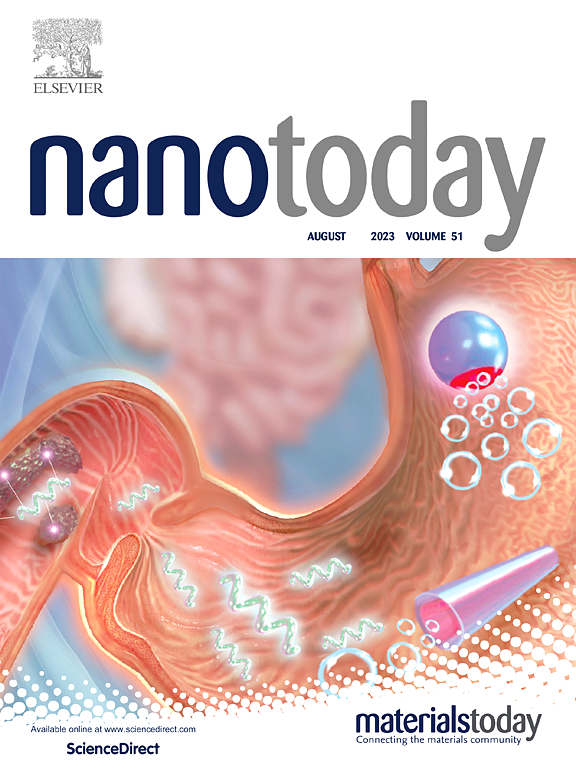A novel hypocrellin B derivative for photodynamic therapy-driven cancer immunotherapy via triggering immunogenic cell death
IF 10.9
1区 材料科学
Q1 CHEMISTRY, MULTIDISCIPLINARY
引用次数: 0
Abstract
The natural photosensitizer hypocrellin B (HB) exhibits restricted absorption within the 650–900 nm therapeutic window thereby impeding its clinical translation. This work synthesizes chemical derivative (HB1) from HB to address its restricted therapeutic-window absorption. Upon 660 nm laser irradiation, HB1 localizes to lysosomes, inducing membrane permeabilization and immunogenic cell death (ICD) while concurrently enhancing dendritic cell (DC) maturation and phagocytosis in vitro through photodynamic therapy (PDT). By further co-encapsulating HB1 and the immunoadjuvant R837 in Poly(lactic-co-glycolic acid) (PLGA) nanoparticles, HB1 induces ICD to release tumor antigens that synergize with R837-mediated immune stimulation, achieving potent antitumor effects via enhanced CD8⁺/CD4⁺ T cell infiltration and DC activation. Furthermore, prophylactic administration of PDT-generated tumor lysates combined with R837 primes antitumor immunity and delays tumor progression. These results substantiate the clinical potential of HB1 for photodynamic immunotherapy and suggest a promising strategy for developing personalized PDT vaccines against tumor recurrence. The approach leverages surgically resected tumor tissues to prepare tumor-specific vaccines, providing insights for clinical translation in cancer immunotherapy.
一种新型的下丘脑素B衍生物,通过触发免疫原性细胞死亡,用于光动力治疗驱动的癌症免疫治疗
天然光敏剂hypocrellin B (HB)在650-900 nm治疗窗口内的吸收受到限制,从而阻碍了其临床转化。本工作合成了HB的化学衍生物(HB1),以解决其有限的治疗窗口吸收问题。在660 nm激光照射下,HB1定位于溶酶体,诱导膜渗透和免疫原性细胞死亡(ICD),同时通过光动力治疗(PDT)增强树突状细胞(DC)的成熟和体外吞噬。通过进一步将HB1和免疫佐剂R837包埋在聚乳酸-共乙醇酸(PLGA)纳米颗粒中,HB1诱导ICD释放肿瘤抗原,与R837介导的免疫刺激协同,通过增强CD8 + /CD4 +的T细胞浸润和DC活化,实现有效的抗肿瘤作用。此外,预防性地将pdt生成的肿瘤裂解物与R837联合使用,可启动抗肿瘤免疫并延缓肿瘤进展。这些结果证实了HB1光动力免疫治疗的临床潜力,并为开发针对肿瘤复发的个性化PDT疫苗提供了有希望的策略。该方法利用手术切除的肿瘤组织制备肿瘤特异性疫苗,为癌症免疫治疗的临床转化提供见解。
本文章由计算机程序翻译,如有差异,请以英文原文为准。
求助全文
约1分钟内获得全文
求助全文
来源期刊

Nano Today
工程技术-材料科学:综合
CiteScore
21.50
自引率
3.40%
发文量
305
审稿时长
40 days
期刊介绍:
Nano Today is a journal dedicated to publishing influential and innovative work in the field of nanoscience and technology. It covers a wide range of subject areas including biomaterials, materials chemistry, materials science, chemistry, bioengineering, biochemistry, genetics and molecular biology, engineering, and nanotechnology. The journal considers articles that inform readers about the latest research, breakthroughs, and topical issues in these fields. It provides comprehensive coverage through a mixture of peer-reviewed articles, research news, and information on key developments. Nano Today is abstracted and indexed in Science Citation Index, Ei Compendex, Embase, Scopus, and INSPEC.
 求助内容:
求助内容: 应助结果提醒方式:
应助结果提醒方式:


